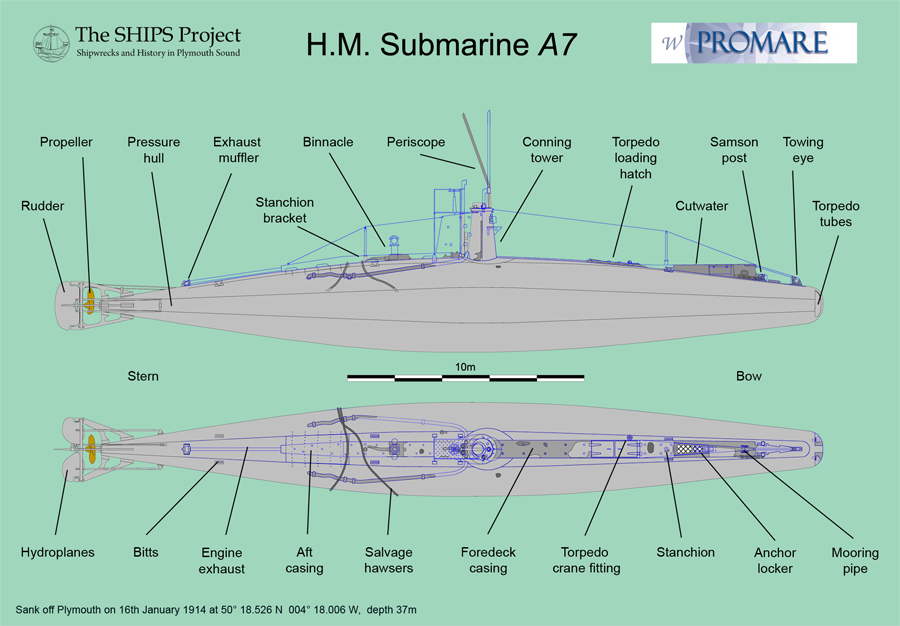Wreck Site 2: Site Plan
This is a condensed version, a full description of the current state of HM Submarine A7 can be found in the Project Report.
When the wreck of the submarine was first found in 1914, between six and seven metres of the submarine’s stern was buried in the seabed and the bow was 10m off the bottom, raised at an angle of 30° to 40°.
All contemporary salvage attempts failed and the submarine was abandoned on the seabed. Sports divers first visited the site in 1981 and found that the submarine was on an even keel, she was largely intact but buried right up to what would be her waterline when afloat and in light ballast.
Current site plan for HM Submarine A7, blue lines showing the location of the original hull fittings which are now missing
Click here to download a high resolution copy of the site plan shown above.
Current site plan for HM Submarine A7, blue lines showing the location of the original hull fittings which are now missing
Click here to download a high resolution copy of the site plan shown above.
In 2014 the submarine was found to be in the same position and attitude on the seabed:
- The main pressure hull was intact apart from three small holes.
- The torpedo tubes were closed but the fairings that covered them had partially corroded away.
- The towing eye was broken, consistent with the accounts of her attempted salvage, but the forward part of the cutwater was also missing.
- The torpedo loading hatch was closed but showed some signs of attempted forced entry
- The casing over the foredeck was largely corroded away
- The conning tower was intact with the main hatch firmly closed.
- The periscope was in position but bent backwards 20 degrees, some nuts had been removed showing that attempts had been made to salvage it
- The casing round the conning tower had corroded away, as had the steering platform
- The casing covering the exhaust pipe has largely corroded away, as has most of the exhaust pipe
- The binnacle is missing, now to be seen in the RN Submarine Museum, Gosport
- The hawsers used to attempt salvage were still in position, wrapped around the hull
- The condition of the stern, rudders and hydroplane are unknown as they are buried

A7 as she lies today, partially buried in thje seabed in 37m water depth
Summary of damage to submarine A7
The damage to the submarine that has occurred after the site was abandoned in 1914 is listed below:
Compass binnacle
Prior to the start of the project the only object known to have been recovered from the submarine was the compass binnacle, originally found by sports divers lying on the seabed by the conning tower on the starboard side of the hull.
Telegraph
The nuts attaching the telegraph to the conning tower top have been removed.
The control rod connected to the telegraph has been cut with a hacksaw and the telegraph removed.
Periscope
The periscope is bent backwards approximately 30° and was in this condition when first seen by sports divers in 1981, so the damage occurred during salvage or after the wreck was abandoned in 1914. Divers have tried to remove the periscope by cutting through it just above the supporting collar. The nuts holding down the supporting collar have been removed leaving just the studs fixed to the top of the conning tower.
Main hatch
The glass in the two side scuttles fitted in the main conning tower hatch are broken.
Port side navigation light
The port side navigation light has been removed from its fitting on the front of the conning tower.
Torpedo loading hatch
One corner of the aft torpedo loading hatch shows signs that a diver has attempted to prise it open.
Holes in the pressure hull
There are three significant holes in the pressure hull
Conning tower
Fishing net is draped over the aft side of the conning tower and ventilator tubes
Cutwater
Fishing net is jammed into the anchor locker in the cutwater and there has been some damage in that area.
This is a condensed version, a full description of the current state of HM Submarine A7 can be found in the Project Report.




